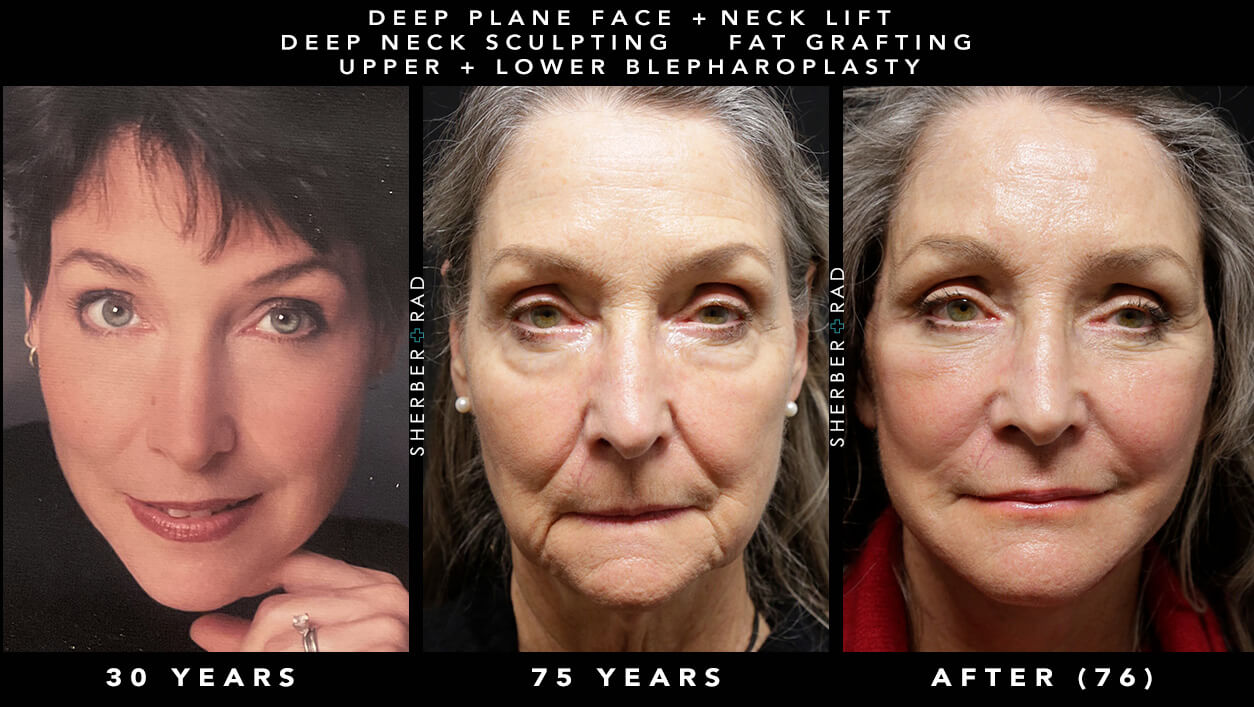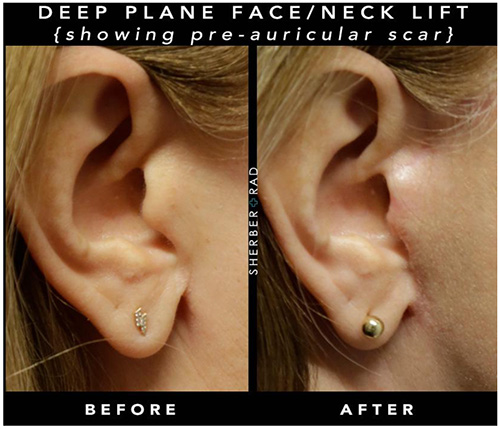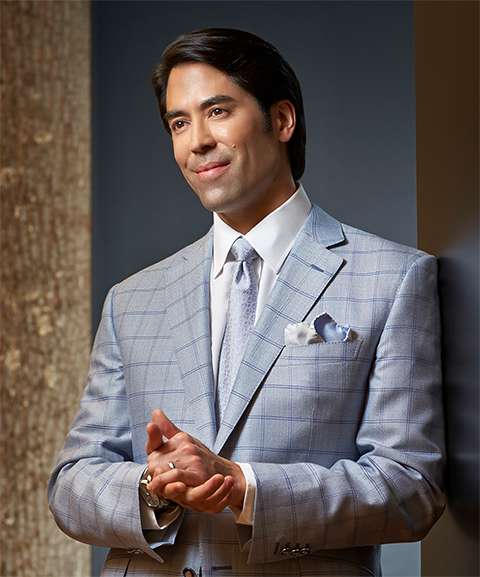- Dermatology
- Plastic Surgery
- Ariel N. Rad, M.D., PH.D.
- Face Cosmetic Surgery
- Breast Cosmetic Surgery
- Body Contouring
- Breast Cancer Reconstruction
- Destination & Travel Package
- Gallery
- Testimonials
- Boutique
- PRESS + BLOG


A facelift is a surgical cosmetic procedure that aims to reduce the signs of aging by tightening the facial skin and muscle tissues. It can help to smooth out wrinkles, reduce sagging skin, and give the face a more youthful and refreshed look.
During the procedure, Dr. Rad will make incisions around the hairline and/or behind the ears, and then lift and reposition the facial tissues, including the skin, fat, and muscle. The excess skin will be removed, and the remaining skin will be stretched and tightened before being sutured closed.
Depending on the extent of the facelift, a patient may need to stay overnight in the hospital, and recovery can take one to two weeks or more.
Ask to see before/after photos as your surgeon should show you multiple examples of his/her expertise.

A facelift is a surgical cosmetic procedure that aims to reduce the signs of aging by tightening the facial skin and muscle tissues. The steps involved in a facelift procedure may vary depending on the specific technique used by Dr. Rad, but generally, the following steps are involved:
It’s important to note that a facelift is a major surgical procedure, and the recovery period can be several weeks. It’s essential for patients to follow their surgeon’s post-operative instructions carefully to ensure the best possible results.
An ideal candidate for a facelift is typically someone who is in good overall health and shows signs of aging in the face and neck region, such as loose or sagging skin, deep creases around the nose, mouth, and chin, jowls, and a double chin. A facelift can improve the appearance of these issues, but it is important to have realistic expectations and understand that it is not a “one-size-fits-all” solution. It is also important for potential candidates to have a consultation with a qualified plastic surgeon to determine if the procedure is appropriate for them and to discuss the potential risks and benefits.
Your vision for your results will emerge through detailed consultation with Dr. Rad, meticulous examination of your anatomy, and careful pre-surgical planning. While Dr. Rad’s surgical approach is unique for each patient, the goal of naturalness remains constant.
Actual Female Facelift Washington DC Patients of Dr. Rad’s
See More Results
Sherber+Rad cannot guarantee specific results.
Individual results may vary.
If you are planning to undergo a facelift, it is important to properly prepare for the procedure to ensure the best possible outcome. Here are some tips to help you prepare for a facelift:
It is important to have a thorough consultation with your surgeon to properly understand the procedure and discuss any specific preparations that need to be made.
Like any surgical procedure, a facelift carries some risks and potential complications. Some of the general risks include:
While these risks are not zero, in experienced and skillful hands, risks are very low. Therefore it is important to find a surgeon who is highly experienced in facelift and facial aesthetic surgery in general. Nonetheless, it is important to discuss these risks with your surgeon prior to the surgery to fully understand the potential complications and how they may be minimized. Additionally, following proper pre-operative and post-operative care can help reduce the risk of complications.
The main difference between a mini facelift and a deep plane facelift is the extent of the procedure and the degree of correction achieved. A mini facelift is a less invasive procedure that focuses on addressing mild to moderate signs of aging in the lateral (outer) face, such as sagging jowls and outer facial wrinkles. It involves small incisions around the ears and can be performed comfortably under local anesthesia. A mini facelift typically has a shorter recovery time of around 1-2 weeks.
A deep plane facelift, on the other hand, is a more extensive procedure that addresses signs of aging on the face and neck, including significant sagging skin, deep wrinkles, and jowls, as well as “turkey neck” and large saliva glands. It involves deeper incisions and repositioning of the muscle and tissue layers in the face. A deep plane facelift requires general anesthesia and may take several weeks for full recovery. Overall, the choice between a mini facelift and a deep plane facelift depends on the individual’s specific needs and desired level of correction.
It is important to consult with a highly experienced (>10 years of practice with specialization in facelift surgery) board-certified plastic surgeon to determine the best approach for achieving your facelift goals.
A SMAS facelift is a surgical cosmetic procedure that aims to reduce the signs of aging on the face by lifting and tightening the SMAS layer (Superficial Musculo-Aponeurotic System). This technique is a modified version of a traditional facelift and is considered to be a more advanced and effective method for achieving optimal results. The surgeon makes a small incision near the ear and the hairline, and then lifts and repositions the SMAS layer.
This provides a more natural-looking lift to the face and also helps to reduce wrinkles and sagging skin. The SMAS facelift may be done on its own or in combination with other procedures, such as a neck lift, brow lift, or eyelid surgery, to achieve a more comprehensive rejuvenation of the face. This procedure requires general anesthesia and a recovery period of several weeks.
Yes, in general, for healthy patients, it is safe to combine a facelift with eyelid lift or brow lift procedures and Dr. Rad commonly performs multiple procedures simultaneously safely and effectively. In fact, combining these procedures can provide a more comprehensive rejuvenation of the face and help achieve a more natural-looking result. Also it offers patients the ability to have a “one and done” refresh with significant advantages in cost, as well.
It is important to note that combining multiple procedures can increase the overall surgical risk, and prolong the recovery period and so you should discuss this with Dr. Rad if you desire more complete facial aesthetic improvement. However, since aging affects the entire face, Dr. Rad has treated many hundreds of patients with comprehensive aesthetic improvements.
Facelift scars are typically located in areas that are hidden or easily concealed. The most common locations for facelift scars are:
The location of the scars may vary depending on the individual’s facial anatomy and the specific technique used by Dr. Rad. A skilled surgeon will aim to minimize scarring and make the scars as inconspicuous as possible to achieve a natural-looking result.

The recovery after a facelift can vary depending on the extent of the procedure and the individual’s overall health. Here are some general guidelines for what to expect after a facelift:
It is important to follow Dr. Rad’s post-operative instructions closely to ensure proper healing and to minimize risks of complications.
A facelift is a surgical procedure, so some amount of pain and discomfort should be expected during the recovery period. However, postoperative pain can be managed with prescription pain medications and over-the-counter pain relief medications as needed. Most patients describe the pain as mild to moderate and generally well-tolerated. During the procedure itself, anesthesia is used to ensure the patient’s comfort and minimize any pain. The type of anesthesia will depend on various factors and will be discussed with the patient during the pre-operative consultation with Dr. Rad. Some people may feel discomfort, bruising, and swelling in the days following the surgery, which can be uncomfortable but manageable with appropriate care and medication.
When speaking about nerves, we must be clear that there are 2 types of nerves: (1) sensory nerves, or those for feeling touch or pressure in the facial skin, and (2) motor nerves which stimulate facial muscles for movement. Sensation nerves are always cut during a facelift and 100% of patients experience numbness in the areas of the neck, jawline, outer face. However, this is not problematic because we don’t rely on sensation of these areas for daily activity. Therfore, all patients having facelift become accustom to reduced sensation and it is not bothersome. To be clear, the lips are NOT included in the area of numbness and the lips, whose sensation is very important, are protected and have normal sensation. Over time sensation does return to the face and neck and it can take 1-2 years. This is normal. The bottom line is that numbness is a normal and expected part of the process of facelifting, it is not bothersome, and over time sensation comes back.
In terms of the risk of motor nerve injury, the risk of nerve damage after a facelift is also low and depends on the individual case and the extent of the procedure. During a facelift, Dr. Rad must reposition and gently stretch deep muscle tissues of the face, which can sometimes cause a temporary “stunning” of a motor nerve that causes the muscle not to function completely normally. The published studies indicate that this chance is around 1-2%, particularly affecting a nerve called the “marginal mandibular nerve” which stimulates a lip “depressor” (pulling-down) muscle called the depressor angluli oris (DAO) muscle. This causes the affected side not to pull down with large smiling or with wide mouth opening (such as with taking a big bite). Although the smile can be slightly asymmetric due to lower lip asymmetry, the nerve nearly always comes back in time, hence the term “nerve stunning”. Permanent nerve injury is very rare due to cross-innervation of the DAO muscle which occurs with nerve regeneration. Temporary lip and smile symmetry can be achieved with Botox to the non-stunned side so that the lower lip position is the same. While this does not accelerate the return of nerve function, it allows the smile and lip function to be symmetric which helps patients feel less self conscious about the asymmetry being noticeable. Botox works for 3 months and can be repeated as needed. Nerve recovery can take 3-6 months or sometimes longer for full function to return.
Although the risk of nerve damage cannot be eliminated entirely, experienced and skilled surgeons take great care to minimize this risk through careful planning, precise technique, and close monitoring during and after the procedure. If nerve damage does occur, it is usually temporary and resolves within a few weeks or months. In very rare cases, permanent nerve damage may occur, which can cause long-term or permanent changes in facial sensation or movement.
While nerve injury is a well-known potential complication of a facelift, the chance is low and depends on several factors, including the skill and experience of Dr. Rad, the extent of the procedure, and the individual patient’s anatomy and health. The facial nerves that control sensation, movement, and expression of the face are often manipulated during a facelift. The nerves can become bruised, stretched, or cut during the procedure, which may cause temporary, or very rarely permanent, nerve damage. The risk of nerve damage can be minimized by choosing an experienced, board-certified plastic surgeon who has a high level of skill and expertise in performing facelift surgery.
Choosing the right facelift surgeon is a crucial step towards achieving your desired results and ensuring your safety during the procedure. Here are some of the most important factors to consider when choosing a facelift surgeon:
For patients seeking the highest level of skill in their surgeon, a minimum of 10 years of experience is generally recommended, and a level of artistry that is reflected in the details of patient results.


Our plastic surgery office in Washington DC is centered on your comfort and privacy. You’ll be received by our exquisitely attentive staff, and escorted to your own private cabana wherein you’ll feel relaxed and comfortable while consulting discreetly with Dr. Rad. First Dr. Rad will determine if you are a good candidate for surgery and during your consultation you should decide if Dr. Rad is the right surgeon for you. Credentials are crucial and, in addition to being Board certified in plastic surgery, Dr. Rad is Assistant Professor at Johns Hopkins, and he enjoys an impeccable reputation as a top flight aesthetic surgeon. His facial plastic surgery expertise is sought out as one of the best surgeons in Washington DC, northern Virginia and the US. Your safety is Dr. Rad's primary concern and he will review your medical history. You should inform Dr. Rad of any medical problems or medications that may affect your healing. If you are medically appropriate to undergo surgery then Dr. Rad's focus will be to understand what specific aesthetic concerns you have. Washington DC patients expect natural results with minimal downtime. Dr. Rad will spend time carefully listening to your concerns, asking clarifying questions and then masterfully guiding you, step by step, to understand how your unique anatomy can be improved to convey a rested appearance. Dr. Rad’s goal is to determine the most comprehensive approach for long lasting, natural results while minimizing downtime. Dr. Rad first needs to understand your specific concerns and you should prepare your thoughts prior to your consultation. Think of words that convey how you feel about your appearance. For example, Washington DC patients often say they look fatigued, tired or lackluster because of undereye bags or dark undereye circles, or they look sad, upset or disinterested such as from heavy eyebrows, excess skin above the eyes or downturned corners of the mouth. Patients often relate concerns of looking older than how they feel and this can be caused by jowls, nasolabial folds, loose neck skin, lines and wrinkles. Try to put into words how your appearance bothers you, and the priority you give to each area. Dr. Rad will then present to you his expert opinion about which procedures would be best to restore your anatomy to create a rested and refreshed appearance. And since surgery is intricate Dr. Rad will guide you through a stepwise approach of aesthetic analysis and he’ll deliver his recommendations in a clear and honest manner. Dr. Rad will present all options available in modern day surgery, both non-surgical and surgical. Dr. Rad and Board certified dermatologist Dr. Sherber often collaborate to optimize patients’ results and to minimize invasiveness. As such Dr. Rad’s modern approach to surgery harnesses the power of both dermatology and plastic surgery as both specialities address different aesthetic challenges. For example, plastic surgery is effective to lift, tighten and volumize loose, atrophied tissues, whereas dermatologic treatments such as laser, radiofrequency tightening and skincare are best to improve skin texture, pigmentation and tone. Dr. Rad can address any concerns regarding skin quality and how to obtain and maintain optimal results. Dr. Rad will review with you photos of his patients’ results (many of which you’ll not find online due to privacy concerns) to highlight his aesthetic approaches and skill. He will take your photographs, which remain confidential, to assist with the planning of your surgery. For your safety Dr. Rad performs surgery in a hospital-based operating room, considered to be the safest environment, rather than in the office. Anesthesia is delivered by a board certified anesthesiologist (MD) and you’ll be under light anesthesia which is important for your safety and comfort. You will receive a customized quote for the procedures in which you’re interested. Once approved we may then move forward with pre-operative preparations and you will meet with Dr. Rad again at your final in person consultation prior to surgery. Dr. Rad’s reputation as one of the most technically gifted surgeons attracts patients nationally and from around the world. We cater to patients from across the globe by arranging virtual consultations, luxury accommodations at The Jefferson hotel, Washington DC’s most luxurious 5 star boutique hotel, as well as private nursing care. Your privacy, comfort and safely achieving exceptional results are our top priorities.

WHAT CAN I EXPECT FROM MY CONSULTATION WITH DR. RAD?

Dr. Rad’s credentials speak for themselves: Princeton (B.S.E, Magna Cum Laude), Duke School of Medicine (M.D.) and University of London (Ph.D.) educated and Johns Hopkins Plastic Surgery trained, he is a Diplomate of the American Board of Plastic Surgery, Assistant Professor at Johns Hopkins, and long-standing member of the American Society of Plastic Surgeons and the American Society of Aesthetic Plastic Surgery. Dr. Rad is considered an expert in facial plastic surgery and microsurgery. He is ranked the #1 plastic surgeon in Washington DC based on aggregate ratings from all independent ranking websites: “top rated local“, “three best rated” top plastic surgeon and “top plastic surgeon reviews“. SHERBER+RAD have never engaged in paid advertising, and all rankings, reviews are from vetted and respected sources.
In Dr. Rad’s DC practice, the cost for facial aesthetic lifts starts at $18,000+ for targeted in office “mini lift”, $29,000+ for more advanced face and neck lifts, (“deep plane” or ponytail methods), $49,000+ for surgeries combining other procedures (blepharoplasty, brow lift, fat grafting, etc.), $75,000+ for complex anatomy, corrective work and up to $150,000 for extensive facial surgery requiring multiple operations (such as adding rhinoplasty, facial bone augmentation or shaping, custom facial implants, etc.). Note that pricing is customized for each patient and these guidelines do not necessarily apply uniformly. Also keep in mind these are approximate ranges and total cost depends on multiple factors: your unique anatomy, goals, complexity of the procedures, recommended techniques, whether corrective work is needed, in-office or hospital-based operating facility, and combining multiple procedures (increasing concessions apply for multiple procedures).
Although you may receive varying cost estimates from other practices, keep in mind that your surgeon’s education and training, plastic surgery board certification, his/her experience (at least 8 years of experience after residency is recommended), and the “X” factor of aesthetic artistry and surgical skill (i.e., talent) of your surgeon are important factors in pricing. Dr. Rad’s goal for every patient is to achieve nuanced and natural results with minimal recovery, and we have mechanisms in place to bring your goals in financial reach.
Dr. Ariel Rad strives to deliver the best facelift Washington, DC has to offer. To find out more about facial cosmetic surgery and our financing options, schedule your consultation by contacting our office today.
We look forward to welcoming you for your private consultation with Dr. Rad
Enjoy a unique experience centered on your privacy and on unhurried attention to your concerns
Or Send a confidential inquiry and our staff will be happy to reach out to you
Sherber+Rad1101 15th St. NW, Suite 100, Washington, D.C. 20005